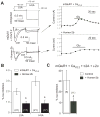The interaction between mGluR1 and the calcium channel Cav₂.₁ preserves coupling in the presence of long Homer proteins
- PMID: 22659088
- PMCID: PMC3439564
- DOI: 10.1016/j.neuropharm.2012.05.038
The interaction between mGluR1 and the calcium channel Cav₂.₁ preserves coupling in the presence of long Homer proteins
Abstract
Group I metabotropic glutamate receptors (mGluR1 and 5) are G protein coupled receptors that regulate neuronal activity in a number of ways. Some of the most well studied functions of group I mGluRs, such as initiation of multiple forms of mGluR-dependent long-term depression, require receptor localization near the post-synaptic density (PSD). This localization is in turn dependent on the Homer family of scaffolding proteins which bind to a small motif on the distal C-termini of mGluR1 and 5, localize the receptors near the PSD, strengthen coupling to post-synaptic effectors and simultaneously uncouple the mGluRs from extra-synaptic effectors such as voltage dependent ion channels. Here the selectivity of this uncoupling process was examined by testing the ability of Homer-2b to uncouple mGluR1 from multiple voltage dependent calcium channels including Ca(V2.2) (N-type), Ca(V3.2) (T-type), and Ca(V2.1) (P/Q-type) expressed in rat sympathetic neurons from the superior cervical ganglion (SCG). Of these, only the mGluR1-Ca(V2.1) modulatory pathway was insensitive to Homer-2b expression. Uncoupling from this channel was achieved by co-expression of an mGluR1 C-terminal protein designed to disrupt a previously described direct interaction between these two proteins, suggesting that this interaction allows incorporation of Ca(V2.1) into the mGluR1/Homer signaling complex, thereby preserving modulation in the presence of scaffolding Homer proteins. This article is part of a Special Issue entitled 'Metabotropic Glutamate Receptors'.
Copyright © 2012 Elsevier Ltd. All rights reserved.
Figures







References
-
- Brakeman PR, Lanahan AA, O’Brien R, Roche K, Barnes CA, Huganir RL. Worley P.F. Homer: a protein that selectively binds metabotropic glutamate receptors. Nature. 1997;386:284–288. - PubMed
-
- Campbell KP, Leung AT, Sharp AH. The biochemistry and molecular biology of the dihydropyridine-sensitive calcium channel. Trends in Neurosciences. 1988;11:425–430. - PubMed
-
- Chemin J, Traboulsie A, Lory P. Molecular pathways underlying the modulation of T-type calcium channels by neurotransmitters and hormones. Cell Calcium. 2006;40:121–134. - PubMed
MeSH terms
Substances
Grants and funding
LinkOut - more resources
Full Text Sources
Other Literature Sources

